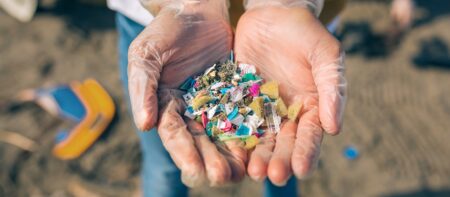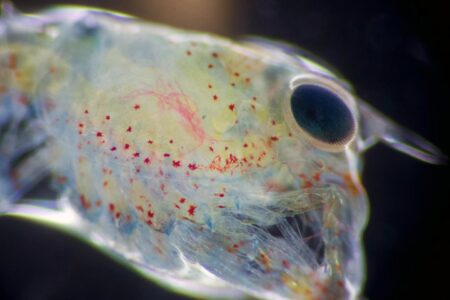The short answer is yes, but to be more specific its Microplastics that they are trying to ban by 2030.
What are microplastics?
Microplastics are tiny bits of plastic, even smaller than 5mm. They stick around for a long time, move around a lot, and are tough to clean up from nature. More and more of these tiny plastic pieces are showing up in the world around us – in the ocean, in the soil, and even in the food we eat and the water we drink.
Once these tiny plastics get into the environment, they don’t break down naturally, and they tend to build up in large amounts unless they are made to break down on their own. Figuring out how to make them break down is a tricky problem, especially in the ocean. People are getting worried about how these tiny plastic bits are affecting the environment, animals, and maybe even our health. (picture of microplastics) Choose a sustainable solution with Organic Bamboo Products.
Where do we see microplastics?
Microplastics are intentionally added to a range of products including fertilizers, plant protection products, cosmetics, household and industrial detergents, cleaning products, paints and products used in the oil and gas industry. Microplastics are also used as the soft infill material on artificial turf sports pitches.
In consumer products, microplastic particles are best known for being abrasives (e.g., as exfoliating, and polishing agents in cosmetics known as microbeads), but they can also have other functions, such as controlling the thickness, appearance, and stability of a product. They are even used as glitter or in make-up.
78 per cent of microplastics in the ocean come from tires, a 2020 report from the Pew Charitable Trust found. Car tires are made from around 24 per cent synthetic rubber – a variation of plastic made using petroleum by-products – that breaks down as the vehicles travel. (source)
We can go on and on about everything that has microplastics in it.

Why should we care, you ask?
Everything we do makes life easier, most of the things we use include some kind of plastic. In fact, the keyboard that I am using is probably 80% made of plastic if not more, the screen I am using, the chair I am using to sit on, there is no end to plastic. If we remove everything that is made from plastic 78-80% of things that we have and enjoy would no longer be available or be way more expensive than just using plastic.
Now, imagine everything good for you is like ice cream. Ice cream is delicious, but if you eat too much, it might make your stomach hurt. Water is super good for us, but if we drink too much, it can cause problems by taking away electrolytes and giving us headaches.
Plastic is a bit like ice cream, too. It’s useful, but if we use it too much, it can cause trouble. When we throw away a lot of plastic, it just doesn’t disappear. It goes on a journey, ending up in rivers and oceans, where it becomes tiny pieces called microplastics. These microplastics can sneak into the food we eat, like fish.
Imagine if you found out that the yummy sushi you love has tiny bits of plastic in it. Would you still want to eat it? We can cook our food to get rid of germs, but what about these sneaky microplastics? It’s like trying to find a way to enjoy our ice cream without eating too much and feeling sick afterward.
All the microplastics that dumped into land seep into ground water and the microplastics in the river water, we use that water to the crops. The plastics also react with pesticides, the cocktail is toxic to the soil and microorganisms (source). We also use disposable water bottles, one of the biggest sources of microplastics, our meals are stored inside plastic containers, etc., There are endless examples of plastic use.
You name it and there is probably micro plastic in it human blood, snow from the Rocky Mountains and Antarctica, and inside the meat and milk of farm animals, etc,.

Accumulated microplastic fibers are visible under this larval lobster’s carapace. New research shows that microplastic fiber pollution impacts larval lobsters at each stage of their development. (Credit)
Plastic is a necessary evil, and we should still try to replace it with other more sustainable and eco-friendly products.
What is being done?
Personally, if you ask me, whatever we do may never be enough. But we should also not give up on this issue. The best thing we can do is educate people, make them aware of the impact we are using something and put it in trash can put the trash out if site, but it never goes aways.
At the Government level, the US government has.
Even though the government hasn’t directly tackled the big issue of tiny pieces of plastic (microplastics), they have done some things about regular plastic. On the big level (federal), they made a law in 2015 saying that cosmetics can’t have those tiny plastic beads in them on purpose. A long time ago, in 1988, they also said that boats can’t throw plastic into the ocean. And there’s another law called the Clean Water Act that tells factories not to let too much plastic go into certain rivers and lakes.
Some states, like California, are trying to make their own rules about plastic. California, for example, planned to reduce tiny plastic pieces in the whole state. They also made a law in year 2022, that wants to reduce how much plastic we use. The law says that companies making plastic things must help clean up and get rid of their stuff better.
Some states, like California, are trying to make their own rules about plastic. California, for example, planned to reduce tiny plastic pieces in the whole state. They also made a law in year 2022, that wants to reduce how much plastic we use. The law says that companies making plastic things must help clean up and get rid of their stuff better. The goal is to use 25% less plastic by the year 2032. Bamboo Flux, a company dedicated to eco-friendly solutions, aligns with these efforts.
What is the EU trying to do?
The EU aims to reduce microplastic releases by 30% by 2030. This will be achieved by
- Reducing plastic pollution (as these degrade into microplastics).
- Restricting the use of intentionally added microplastics to products.
- Reducing unintentional microplastic releases.
Here is the source, you can read about from about what EU is doing. I sincerely believe that USA or as a matter of fact every country can look at EU and do something about this issue, I know it’s easier said then done. I just hope by the time the everyone in the world is made aware if this topic, it might be too late to anything.


I loved even more than you will get done right here. The overall look is nice, and the writing is stylish, but there’s something off about the way you write that makes me think that you should be careful what you say next. I will definitely be back again and again if you protect this hike.